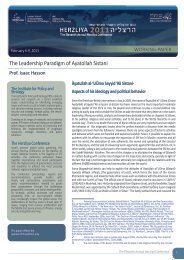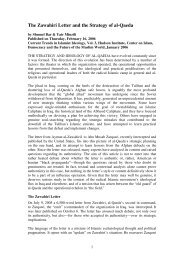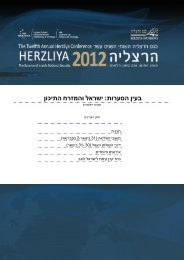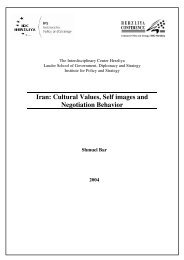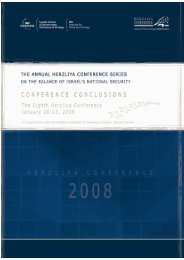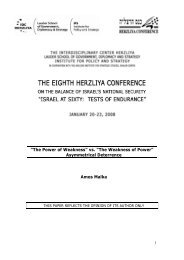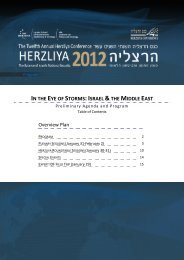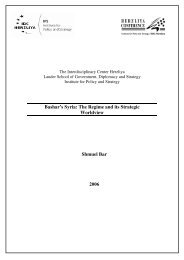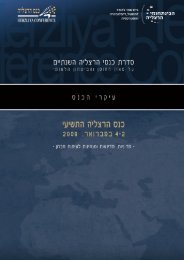Classical Islamic Paradigms of Deterrence and their Expression in ...
Classical Islamic Paradigms of Deterrence and their Expression in ...
Classical Islamic Paradigms of Deterrence and their Expression in ...
You also want an ePaper? Increase the reach of your titles
YUMPU automatically turns print PDFs into web optimized ePapers that Google loves.
danc<strong>in</strong>g <strong>and</strong> the use <strong>of</strong> body colors by early hom<strong>in</strong>ids <strong>in</strong> Africa. When hom<strong>in</strong>ids first went to the open grassl<strong>and</strong>s <strong>in</strong> Africa, they needed to f<strong>in</strong>d ways to deter large predators, later other groups. Ritualistic stomp<strong>in</strong>g,danc<strong>in</strong>g, mak<strong>in</strong>g noises <strong>and</strong> mutual body-pa<strong>in</strong>t<strong>in</strong>g served as social mechanisms to glue groups together,replace <strong>in</strong>dividual awareness with collective awareness, <strong>and</strong> enter a state <strong>of</strong> "battle trance" to deter orfight enemies. 57 Thus, group build<strong>in</strong>g, collective identity <strong>and</strong> deterrence are closely connected to commonrituals <strong>and</strong> one element strengthens the other. This partly answers questions <strong>of</strong> ratio beh<strong>in</strong>d the collectivebehavior <strong>of</strong> religious sub-state actors’. The need to constantly renew group identity serves as a driv<strong>in</strong>gforce to develop deterrence paradigms <strong>and</strong> vice versa.German jihadis who stayed at tra<strong>in</strong><strong>in</strong>g camps <strong>of</strong> the <strong>Islamic</strong> Movement <strong>of</strong> Uzbekistan <strong>in</strong> Waziristan between2009 until 2011 have explicitly described <strong>their</strong> condition<strong>in</strong>g, when they were <strong>in</strong>terrogated by the Germanpolice. "The stay at the <strong>Islamic</strong> Movement <strong>of</strong> Uzbekistan was governed by a rigid daily schedule, whichcomprised common prayer, read<strong>in</strong>g the Qur'an as well as communal sports activities <strong>and</strong> shared d<strong>in</strong>ners." 58In addition, common s<strong>in</strong>g<strong>in</strong>g <strong>of</strong> traditional <strong>Islamic</strong> battle songs (huda' <strong>and</strong> anasheed), as well as ritualpassages <strong>of</strong> motivation <strong>and</strong> loyalty (bay'a) were used to <strong>in</strong>duce "battle-trance" states, group cohesion <strong>and</strong><strong>in</strong>timidate enemies. In comb<strong>in</strong>ation with actual battle operations, this resulted <strong>in</strong>to a strong socioideologicalglu<strong>in</strong>g together <strong>of</strong> some <strong>of</strong> the German jihadis with the Uzbeks. 59 The group cohesion wasdisturbed by hierarchy conflicts with<strong>in</strong> the German sub-group, which took place between "elders" <strong>and</strong>"novices," i.e. those who arrived later from Germany. This <strong>and</strong> the rough atmosphere was the reason thatsome German jihadis quickly left the Uzbek tra<strong>in</strong><strong>in</strong>g camps. The Germans, who stayed, however, became<strong>in</strong>doctr<strong>in</strong>ated. They were conv<strong>in</strong>ced that <strong>their</strong> appearance alone would frighten <strong>and</strong> deter U.S. soldiers(stationed <strong>in</strong> Afghanistan). 60 "The defendant described himself as a man not from this world, but from thehereafter. He strived to live with his whole family <strong>in</strong> paradise. Enemies he saw would be beheaded by him;American soldiers were afraid <strong>of</strong> him <strong>and</strong> the likes <strong>of</strong> him. He summoned his father to move to him at theend <strong>of</strong> his live <strong>in</strong> order to participate <strong>in</strong> jihad <strong>and</strong> die as a martyr." 61This example <strong>of</strong> the psychology <strong>of</strong> a young European jihadi is very tell<strong>in</strong>g. The recruit fully <strong>in</strong>corporatedsimple jihadi myths <strong>of</strong> community, enmity <strong>and</strong> salvation, which led him to believe that the sole aura <strong>of</strong> hisgroup spreads dreadful fear among the enemies. This was paired with an excessively exaggerated selfperceptionas liv<strong>in</strong>g martyr, based on an undifferentiated <strong>and</strong> awestruck veneration <strong>of</strong> martyrdom culture,which one might call ittiqa' al-istishhadiyya.Specific group behavior <strong>and</strong> rituals strengthen the collective identity, but also anger on the perceivedenemy. The result is ever more dissociation from ma<strong>in</strong>stream society, which evokes display <strong>of</strong> power.Group rituals around martyrdom ideology dim<strong>in</strong>ish fears from death, <strong>in</strong>timidate the enemy <strong>and</strong> havestrongly dis-<strong>in</strong>hibit<strong>in</strong>g effects. This cultivation <strong>of</strong> martyrdom <strong>and</strong> deterrence among Muslim sub-state actorsdoes not resemble "classical" paradigms <strong>of</strong> Cold War th<strong>in</strong>k<strong>in</strong>g. It is rather based on primordial small-groupsocialization, religious fear <strong>and</strong> concepts <strong>of</strong> endemic warfare.Just as there are different ways to dim<strong>in</strong>ish fear, there are common ways to learn <strong>and</strong> condition fears.These are the own experience, such as play<strong>in</strong>g with fire; the observance <strong>of</strong> members <strong>of</strong> the own species<strong>and</strong> group, i.e. learn<strong>in</strong>g at a model; <strong>and</strong> <strong>in</strong>struction by warn<strong>in</strong>gs, rules <strong>and</strong> threat scenarios. A psychological57 Joseph Jordania, "Why do Humans S<strong>in</strong>g? Music <strong>in</strong> Human Evolution", Logos, 2011.58 "Der Generalbundesanwalt beim Bundesgerichtsh<strong>of</strong>; Anklageschrift gegen W.S." 2 BJs 40/11-8-2 StE 10/11-8, Karlsruhe, den 26. October2011.59 Ibid.60 Ibid <strong>and</strong> <strong>in</strong>terrogation protocol by German Federal Police <strong>of</strong> R.M.61 Ibid.18



